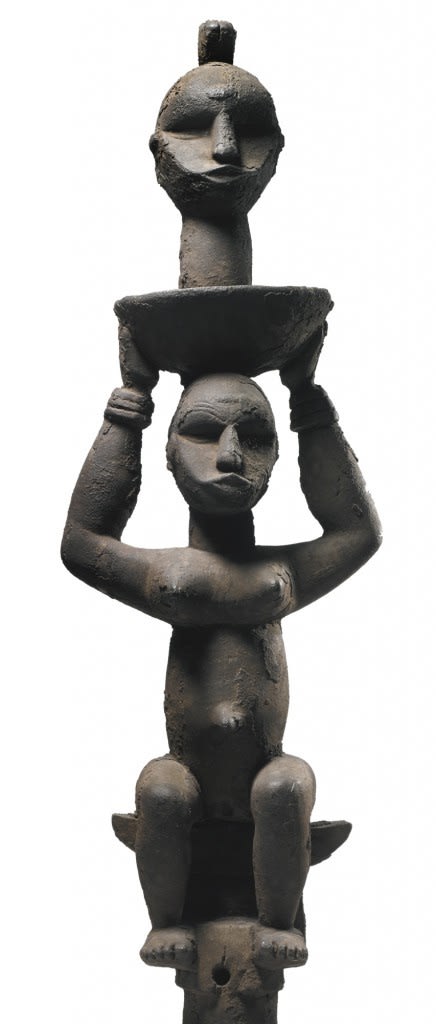
The above headdress, lot 57 in the Kunin sale at Sotheby’s New York was listed as Eket in the sale catalogue. Since slightly similar figural crest masks such as this one were illustrated by Francois Neyt in L’art Eket (1979) and other publications, headdresses such as the one under discussion here, have been incorrectly attributed to the this group. The treatment of the face as a curving plane with sharp edges and the disproportionate emphasis on the spherical head indeed are very reminiscent to the well-known Eket stye (compare to the example illustrated at the end of this article).
In reality these headdresses originate from the southern Igbo. G.I. Jones and K.C. Murray visited the Olokoro (an Igbo group) near Umuahia in the late 1930s. Jones photographed a very similar headdress (illustrated below), while Murray collected several examples. Jack S. Harris in 1939 also collected two very similar headdresses near Umuahia (illustrated below); these were said to have been carved by an Ibibio sculptor.

A number of ogbom headresses were thus commissioned by Igbo from Ibibio carvers, and others were locally made. According to Herbert Cole it’s unlikely that all known ogbom headdresses were carved by Ibibio (or Eket), so possibly local artists copied the style. There were old trade routes between the two areas via the Kwa Ibo River. Furthermore, the Umuahia area was a marginal area where Igbo, Ibibio, Cross River and Ijo peoples and cultures intermingled, with the Igbo predominating. From the days of the slave trade onward it was also an important distribution center for trade. The principal market was at Bende, where trade routes from the Niger via the Northern Igbo, and the Benue via the Idoma and North-Eastern Igbo converged, and where the slaves could be routed southwards to the coast. At the same time the imports received from the south were traded northwards along the same routes.
The characteristic feature of this style lay in the treatment of the lower part of the face, we notice an exaggerated subnasal prognathism. The lips and chin project well beyond the nose and the upper part of the face. In support of this distortion the lips are over-large in size and prominence, particularly in relation with the chin, which recedes beneath them; the cheek- bones and the angle of the jaw disappeared, as did the line of the jaw, which was displaced by a line which ran from the corner of the lips to the outer edge of the brows. The eyes are reduced to slits between straight, insignificant narrow lids hidden beneath the overhanging brows. This exaggeration of the forward projection of the lips can also be found in some Ibibio Anang figures, but not to the same extreme. Lastly, most ogbom carry the local ‘tribal’ marks, namely keloids grouped into small rectangules or ovoids, one on each temple and one between the eyes. In some case they were represented vertically, in others horizontally.

These full-figure headdresses are worn in ogbom dances – these were known among the following Igbo groups: Ibeku, Olokoro, Oboro, Ngwa, and Ozu-Item. While Ibibio style features are present, there is no reason to ascribe the origin of the ogbom cult and art to these neighbors.
Versions of this dance employing carved headdresses seem to have been moribund in the early 1940s. In Olokoro, in 1966, Cole was told that ogbom had last been performed as a masquerade in 1952, but that it continued to be celebrated as a dance (without the headdress). Other sources tell that men still wore the headdresses by the 1930s, but their identity was not concealed (thus they were not supernatural beings), and these carvings had not been made since the nineteenth century.
Ogbom displays honored ala (earth) and called attention to her role in human and agricultural fertility and increase. In some areas it was a harvest celebration. During part of the performance women entered the arena to dance and sing around the ogbomcarrier. Connections with female productivity and nurture are emphasized in the carvings themselves, which are overwhelming female, nearly always depicted with large full breasts.
Many of the known ogbom carvings are young females seated on stools holding a disc-like plate above their heads with a human head. These heads would seem to be trophies of war. Since this Igbo area was once known for headhunting, this iconography would appear to refer (at least indirectly) to the role of the heads of slain enemies in bringing power and increase to the receiving community.
Murray describes an elaborate, colorful costume for ogbom carriers. Around the cylindrical base basketwork was woven, and this enabled the carving to be lashed to the dancer’s head. ‘Through a hole in the base of the carving a stick is fitted so as to protrude horizontally at front and back. On the front a conical basket about four feet long is fixed, and at the back an arrangement of cane and raffia shaped like a wheel’. All of that was covered with fine cloths and parrot feathers, and there was a tail-like projection at the dancer’s rear. Murray is equivocal about the wearer’s costume and extent of disguise. At one point he says, ‘The face and body of the dancer are completely covered with a special white-colored native-woven cloth with reaches down to his feet’, and later he indicates that the identity of the carrier was not concealed. In any case, ogbom performers danced in an open area before a shed specially erected for musicians, who used to types of membrane drums plus nine small ‘bowl drums’ of graded size. Murray tells us that ‘women moved about joyfully in compact bodies while parties of men moved forwards and backwards in front of the shed. The dancers wearing the costumes entered singly in a scene of great excitement and danced before the shed and, without touching their cloths, twirled their cloth around their tails merely by their dancing’.

